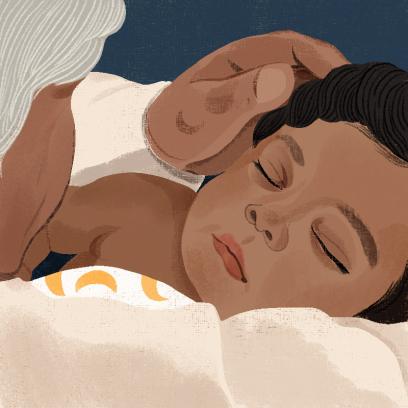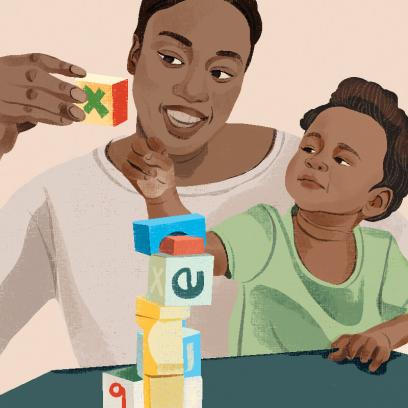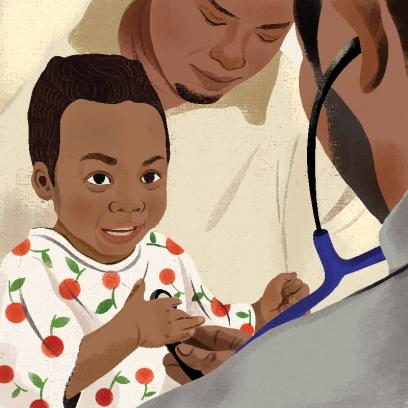In the United States today, some groups of people are at higher risk for poor health and are less likely to have access to preventive medical care.1 With low income being a major risk factor for poor health, it should be a grave concern to all health professionals that as many as two in five babies are born to families with incomes at less than twice the federal poverty line, and that Hispanic and Black infants and toddlers are, respectively, more than two and three times as likely to live in poverty as their white counterparts.2 By nearly every measure, children living in families with low incomes and children of color face the biggest obstacles to good health, such as low birth weight, unstable or crowded housing, and limited access to early learning experiences.3 Although these complex problems have many causes, primary among them are systemic racism, along with other forms of marginalization and discrimination, and resulting wealth disparities—all of which are longstanding and still occurring.4 The COVID-19 pandemic exposed and exacerbated these disparities and structural barriers, which have harmful, life-altering effects that begin before birth and too often result in premature illness and death. Now more than ever, attention is needed to ensure that high-quality preventive physical, mental, and behavioral healthcare is provided to young children and their parents and caregivers.*
Understanding and Addressing Health Inequity
Some of the factors that exert the greatest impacts on health across the lifespan are healthy pregnancies, adequate housing, good nutrition, family stability, quality education, steady jobs with adequate wages, safe communities, and other social determinants of health (SDOH).5 To tackle health inequity, we must pivot toward wellness and prevention with an explicit focus on young children and their caregivers. Pediatric primary care† is the only system in the country that reaches nearly all young children and their families regardless of race or class, creating an opportunity to provide support as early as possible in the life of a child.6 Because not all babies, toddlers, or preschoolers attend early learning and childcare settings—or even have access to these settings—pediatric primary care is the way to most universally reach these children before kindergarten. No other system has the same consistent and positive connection to families, their young children, and their communities or stands to make the kind of broad-scale influence on our collective prosperity. This connection provides a unique opportunity to understand and support the holistic needs of the family—especially when visits to the pediatric provider are intentionally nonstigmatized and families feel safe sharing nonmedical concerns.
To be comprehensive, pediatric primary care requires providing services to young children and their caregivers with a two-generation lens. While this may initially appear to be outside the scope of pediatrics, consider a visit focused on sleep training: the ideal focus of the intervention is the whole family, not just the infant, because an infant who doesnt sleep impacts the whole family, and because the infant will not be following the sleep training guidance independently. Pediatric practices should promote wellness and well-being by providing preventive education and referring to early intervention or other services for the child, caregivers, and the family, mitigating the need for more intensive and costly interventions—not to mention preventable suffering—later in life. These family-oriented services are the bedrock of high-quality pediatric primary care and set the most vulnerable children on a healthy life trajectory.
The frequency of primary care use by young children and their caregivers (12 to 13 well-child visits in the first three years of life) provides an early port of entry into a strengths-based partnership between families and providers. The American Academy of Pediatrics urges pediatricians to screen for maternal depression, behavioral and developmental risks, and SDOH such as food and housing insecurity; they also recommend addressing these issues through a care team—which includes nurses, therapists, community partners like social workers and educators, and the family itself—as an innovation to improve pediatric care.7
Although primary care providers largely recognize the importance of screening for SDOH, they may not always carry it out. A 2014 survey of pediatric screening and referral practices among families with low incomes showed that pediatricians were less likely to screen if they felt it was not feasible at their clinics or if they felt unprepared to address families’ social needs. Pediatricians were more likely to screen for SDOH and make resource referrals if someone in their clinic was responsible for connecting families to services.8 Still, even when pediatric practices do screen for risks, families cannot necessarily access important resources and services. According to the 2018–2019 National Survey of Children’s Health, among families with young children (0–5 years old) who needed help arranging or coordinating their children’s care among different doctors or services, only 29.3 percent said they received that support.9 This lack of follow-up and support further cements health inequities and limits a child’s ability to thrive.
Preventive, team-based care offers a remedy, allowing pediatric and family medicine practices to take steps toward two-generation universal screening and early intervention follow-up. Team-based care is a delivery model in which patients’ health-related needs are addressed as coordinated efforts among multiple providers and across settings of care, including helping with housing and nutrition. The impact of this model is significant for both patients and the care team: “If team-based care is thoughtfully implemented and fully supported, each team member’s contribution to the overall well-being of the child is valued.... When clinicians feel connected to their patients and receive personal satisfaction from their work, they are more engaged and are less subject to burn out. Highly engaged and satisfied members of the care team have a positive effect on patient care and outcomes.”10
The remainder of this article describes HealthySteps—a model of preventive, team-based care focused on infants, toddlers, and their caregivers—and outlines essential common elements for this and other models to effectively ameliorate health inequities. Achieving comprehensive coordinated care is not easy, so we also address major barriers to implementation and the benefits of alternative payment models that value a broad picture of health and thus support preventive, team-based approaches.
What Is HealthySteps?
As a team-based, preventive-care model, HealthySteps, a program of ZERO TO THREE, brings focus to the important array of skills, knowledge, and connections needed for families to foster healthy child development and lifelong well-being. When implemented to fidelity, HealthySteps leads to improved outcomes, especially in areas where there have been persistent inequities for families of color or those with low incomes.11 HealthySteps has eight core components designed to provide positive parenting guidance, connect families to community resources to meet children’s and caregivers’ needs, and foster caregiver-child relationships that nurture children and buffer them from the effects of toxic stress.‡
To ensure delivery of the core components, a skilled child development professional known as a HealthySteps Specialist (HS Specialist) is integrated into the pediatric primary care team. HS Specialists have the time and training to support both common and complex child and family problems, including (but not limited to) feeding and nutrition, behavior, sleep, attachment, maternal depression, social needs, and adapting to life with a baby or young child. An emphasis on building healthy relationships—between caregivers and children, between families and healthcare providers, and among healthcare professionals—is one of the model’s guiding principles. HealthySteps thus builds on and enhances the trust caregivers have in pediatric primary care providers.
HealthySteps practices aim to help all children from birth to three years of age,§ as well as their families, by employing a three-tiered approach based on family needs and risk factors. In the first tier, child and family screenings and access to a child development support line are offered universally. In the second tier, families with mild to moderate concerns receive short-term consultations on development and/or behavior, along with referrals to needed services, care coordination, positive parenting guidance, and early learning resources. In the third tier, families with the greatest risk factors and/or needs receive a series of team-based well-child visits coordinated and guided by a HS Specialist. Some universal services (such as screening) are provided by front-desk staff, medical assistants, nurses, and other team members so that doctors and HS Specialists can focus on families with the most needs. This approach allows practices with a single HS Specialist to serve up to 2,000 children and their caregivers annually.12
Essential Principles of Preventive, Team-Based Care
The essential principles of effective, evidence-based models like HealthySteps are relationship-based care, a two-generation approach, a focus on SDOH, developmental and behavioral screening and follow-up, and trauma-informed care. Together, these elements provide a constellation of services that can work to prevent child health inequity from occurring in the first place, while also intervening when needed, as early as possible.
Relationship-Based Care
Relationships are at the heart of the HealthySteps model. Fundamentally, nurturing, warm, and responsive relationships between caregivers and their children help lead to healthy and positive child development. Parenting can be difficult and regular access to trustworthy parenting guidance scarce. By providing open access to a child development specialist, such as a HS Specialist, effective models give families resources and support to address common parenting concerns and identify atypical behavior early.
HS Specialists cultivate relationships with families and, as part of the pediatric team, can help build relationships between the family and the pediatric clinic. When pediatric practices consider that there are three perspectives in the room—the provider’s, the caregiver’s, and the child’s—the family’s voice is more fully represented. Further, there is often a parallel process occurring when practice staff interact with families. The way that providers and other staff communicate with caregivers impacts how they feel (and what they will share and ask) in that moment and how they might interact with their children later. When providers engage reflectively—paying full attention when caregivers are speaking, using body language to convey interest, and managing their own emotional response to what is being shared—they model how caregivers can interact with their babies and toddlers.
Patient engagement is an area of growing interest in healthcare as providers seek to understand why recommended treatment plans are not always followed.** Research highlights the importance of person-centered care in creating positive patient-provider relationships.13 These relationships are vital for creating partnerships with families with young children that produce positive results. For example, a multisite evaluation found that families in HealthySteps practices were significantly more likely than those in regular pediatric practices to report that practice staff went out of the way for them, and mothers in HealthySteps practices were more likely to rely on practice staff for advice than a relative, book, or other source.14 In another study, families rated their HealthySteps provider as more competent and caring and were significantly more likely to believe that the healthcare team cared about them.15 Across a group of practices with the HealthySteps model in place, when surveyed 30 months after adopting HealthySteps, clinicians noted four times the odds (compared to baseline) of being satisfied with their ability to provide quality supports to caregivers.16
Two-Generation Approach
Caregivers’ wellness is necessary for children to thrive because it directly affects children’s health and well-being. In a two-generation model, the quality of attachment between a caregiver and child can be continually observed and supported. Improving awareness, providing parenting education, and conducting mental health screenings enhance the likelihood that caregivers will get the support they need as early as possible. When caregivers receive timely support and other needed services, physical, mental, and behavioral health outcomes for children can improve. If caregivers build positive, loving relationships with their children, they create buffers that can protect their children, interrupting stressors that perpetuate intergenerational cycles of challenges and reducing the impact of trauma. HealthySteps’ two-generation approach aligns closely with existing, widespread child abuse and neglect prevention efforts as well as efforts to improve caregiver mental health.
Untreated maternal depression and anxiety affect caregiver-child attachment and the healthy development of young children. The Centers for Disease Control and Prevention estimates that postpartum depression affects 11 to 22 percent of mothers in the first six months after giving birth, with American Indian/Alaska Native, Asian/Pacific Islander, and Black mothers being at the higher end of that range and white and Hispanic women at the lower end.17 Several studies have found that among women living in poverty, postpartum depression is two to four times more common than among women in middle- or upper-middle-income households; socioeconomic status is considered the most dependable predictor.18 Despite this high risk, one study found that women with public insurance (a proxy for low income) had lower postpartum screening rates than women with private insurance (56 percent versus 68 percent, respectively) and that African American and Hispanic women had lower postpartum screening rates than white women (49 and 56 percent versus 67 percent, respectively).19
HealthySteps and other integrated, two-generation care programs ensure more frequent screenings, create more opportunities for prevention, and support treatment of perinatal mood and anxiety disorders. As part of a quality improvement project at a practice in rural Arizona, HealthySteps increased the screening rate for maternal depression from 41 percent to 92 percent over five months.20 This practice serves more than 300 Native American families from the Hopi, Navajo, San Carlos Apache, and White Mountain Apache nations among its patient population. Importantly, in HealthySteps practices, mothers experiencing depression reported significantly fewer symptoms after receiving care and noted that symptoms decreased at a faster rate than comparable mothers.21
Attention to Social Determinants of Health
As noted above, a focus on SDOH as upstream drivers of inequity is critical to enhance family wellness. An integrated care model can identify SDOH early and connect families with timely services. Screening for SDOH can be complicated because most current tools focus on individual areas; there is a need for more comprehensive, validated screening tools. Fortunately, the Centers for Medicare & Medicaid Services recently released a screening tool and guidance for practices to determine families’ health-related social needs.22
Before this tool was available, HealthySteps developed the Family Needs Questionnaire to screen for key SDOH and other risk factors that may affect families served by HealthySteps practices. Five essential needs were identified (these were consistently found across existing screening tools): food, housing, utilities, transportation, and safety. HealthySteps added questions about tobacco and substance misuse (alcohol and other drugs) to capture a more comprehensive picture of family needs using a single screening tool. To address concerns related to language and literacy accessibility, questions were selected from validated screening tools, with literacy levels ranging from sixth to ninth grade, and versions are available in English and Spanish. Annual screening for SDOH using either the Family Needs Questionnaire or another adequate tool is required at all HealthySteps practices.
Of course, screening is only the first step; once needs are identified, families need to receive appropriate referrals and be connected to the relevant services.23 To help make those connections and thereby more comprehensively address SDOH, some HealthySteps practices add community health workers to the team. Preliminary research suggests that in a group of urban HealthySteps practices, referrals made with HS Specialist support were successful in 74 percent of attempts at connecting families with the appropriate services.24 This is well above recent studies looking at referral rates in pediatric medical settings to community services (which hover around 61 to 64 percent). When a community health worker was added to the team alongside a HS Specialist, successful referrals were even higher: 96 percent.
Developmental and Behavioral Screening and Follow-Up
For years, the American Academy of Pediatrics has recommended that pediatricians routinely use validated screening tools to identify risks to development in every child as effectively and as early as possible.25 Despite this recommendation, US screening rates remain consistently low. Only 36.4 percent of parents responding to a national survey reported having completed a developmental screening tool when their child was between 9 and 35 months of age.26 When children receive primary care in a medical home—care that is coordinated, family centered, accessible, continuous, and comprehensive27—the number of children screened rises to only 43.5 percent.28
HealthySteps requires annual, universal screening for development. This allows for tracking of developmental milestones and lays the groundwork to address challenges early by connecting families and children to services. Without clear referral and follow-up protocols, many families cannot access the services they need. Studies have found stark income- and race-based disparities in early intervention services:
- Among babies who had been in neonatal intensive care, those in single-parent households waited an average of 24 days longer than those in two-parent households to start receiving prescribed intervention services; parents of color and single parents reported putting forth greater effort to find services.29
- Children from families making $20,000 or less per year were 13.6 percent less likely to receive physical therapy and 10.4 percent less likely to receive occupational therapy than children from higher-income families.30
- Black children were five times less likely to receive early intervention services than white children at 24 months of age.31
HealthySteps works to successfully connect families to early intervention services by understanding family concerns (e.g., those who have experienced racism and pervasive bias may be particularly wary of special education diagnoses and systems) and ensuring that the systems of care are well coordinated with each other and that all are centering the family.
Narrowing specifically on one element of development, we know that early diagnosis and treatment leads to more positive outcomes later in life for people with autism spectrum disorder (ASD). Yet, children of African American, Hispanic, and Asian descent, and children living in families with low incomes, are less likely to receive an early diagnosis of or early intervention for ASD than white children, despite similar prevalence of ASD across racial/ethnic groups.32 HealthySteps facilitates timely screenings and referrals for ASD by screening all children. One HealthySteps practice with integrated behavioral care offers a strong model: of children who screened at the high-risk level, 90 percent received a developmental evaluation, and the median age of ASD diagnosis was two years earlier than the national median (26 months versus 52 months).33
Trauma-Informed Care
Research on childhood adversity has demonstrated that child abuse and neglect can disrupt a child’s developing brain, negatively influencing behavioral, educational, economic, and health outcomes for decades and even generations. Trauma-informed pediatric care that is culturally competent, reflective, and focused on families’ strengths empowers families to interrupt intergenerational transmission of trauma and can help to mitigate secondary trauma in providers.34
HealthySteps enables practices to identify children and families most at risk for child abuse and neglect and address their needs to prevent nascent concerns from escalating. The trusting and longstanding relationships that HS Specialists establish with families during these early years allow sensitive subjects to be addressed in a safe setting and to be monitored through frequent appointments. A recent study noted that children of mothers with a history of childhood trauma scored better on a social-emotional screening after receiving care in a HealthySteps practice than comparable children who were not in the program.35 Another study found that HealthySteps parents were less likely to resort to using harsh forms of punishment (threatening, yelling, spanking with hand) or severe discipline (face slap, spanking with objects) than comparable non-HealthySteps parents.36 A longitudinal analysis showed that parents who participated in HealthySteps noted fewer behavior problems among children 16 to 37 months old and showed greater attachment security.37
The benefits of preventive, team-based care focused on young children and their caregivers are clear. However, current policy and payment landscapes do not allow for this kind of programming to be the expectation rather than the exception. As we seek to ensure such services are available to all families, changes will need to occur.
Barriers to Integrated Care
Despite the many benefits of preventive, team-based care models, there are barriers to sustaining integrated programs built into our medical health insurance reimbursement policies. Here are three of the most common obstacles.
- Behavioral or mental health visits are not allowed on the same day as a medical visit. In some states, medical insurance carriers may only reimburse for one type of visit on a given day (known as same-day billing). The lack of financial acknowledgement of both visits on a given day creates a barrier to rendering high-quality care. Typically, the families most in need of integrated services are those least able to make multiple visits spread over different days. Therefore, doing what is best for the family threatens the financial viability of the team-based practice.
- Restrictions on behavioral health licensures eligible for medical insurance reimbursement. While a robust team of providers with varied backgrounds and experiences benefits a diverse patient base, restrictions around insurance prevent payment for certain providers. Not all behavioral and mental health professionals are recognized for medical insurance reimbursement. Licensures eligible to file medical claims for the services they have rendered are restricted in many states. One example is that some states do not recognize community health workers’ care coordination for separate reimbursement.
- Many preventive services are not recognized for medical insurance reimbursement. Services such as positive parenting guidance and information, child development support lines, and ongoing preventive team-based well-child visits are not recognized for separate reimbursement in many states. Maternal depression screenings rendered during well-child visits are also not recognized for separate reimbursement in some states. The diagnosis requirement precludes almost all behavioral health and developmental prevention services from being paid. This, in turn, makes early intervention less likely and results in much suffering and far higher costs—most of which could have been prevented.
Fortunately, shifts in reimbursement for the coordinated-care model are occurring. For example, California’s Medicaid system, Medi-Cal, reimburses for California’s family health benefit, which focuses on preventive two-generation supports via family psychotherapy and is geared toward preventing mental health conditions in children with specified risk factors. These services can be rendered by any licensed behavioral health clinician and are unlimited for patients under the age of 21 with approved risk factors. These risk factors are associated with SDOH for the child and/or for the caregiver. In addition, Medi-Cal will reimburse for up to five sessions when a mental health diagnosis is suspected, giving clinicians valuable time to assess whether a diagnosis is warranted and to plan for treatment. While such advances are welcome, a more radical change in our payment policies is needed to reap the full potential of preventive, team-based care.
Developing an Alternative Payment Model
A child- and caregiver-focused alternative payment model could help increase focus on the early years as the foundation for a healthy life and incentivize providers to address child and caregiver needs well beyond physical health. In addition, such holistic and equitable supports for caregivers in the context of their young children’s pediatric visits would drive cost savings.38 Given the frequency of primary care use by young children, an alternative payment model that includes services to caregivers and allows multiple types of care in each visit would encourage primary care providers to deliver preventive high-quality services, including integrated behavioral health services and health-related social needs supports. Providing these interventions in the context of pediatric primary care has the potential to drive significant improvements in health outcomes and to reduce total cost of care for the family unit (and, ultimately, for our nation). A well-designed alternative payment model should aim to achieve value-based care, meeting the quadruple aim of improved patient experience of care, improved health of the population, improved clinical experience, and reduced cost of care.39
As the COVID-19 pandemic continues to unfold, there are many unknowns about the long-term impacts on the physical and mental health of children and adults. Data already show declines in children’s and caregivers’ well-being. Between March and June 2020, “27 percent of parents reported worsening mental health for themselves, and 14 percent reported worsening behavioral health for their children.”40 Such increased physical and behavioral health needs, paired with ongoing or new family needs, including sudden job loss and food and housing insecurities, have the potential to add significant costs to state Medicaid and cross-system partner agencies. This is in addition to the negative impact of ongoing inequities experienced by communities of color.41 These are serious health challenges calling out for integrated, team-based care. An alternative payment model could encourage providers to offer critical comprehensive services to children and caregivers in the pediatric primary care setting, addressing needs in a timely manner while bending the cost curve in an era when health expenditures are on the rise.
As the single most commonly accessed system in early childhood, pediatrics is the ideal setting to provide comprehensive, coordinated care, with supports to meet each family’s needs. At the time when children’s brains are developing most rapidly, integrated care programs like HealthySteps foster healthy child development and lifelong well-being, leading to improved outcomes especially in areas where there have been persistent inequities for families of color and those with low incomes. The need is apparent and the knowledge exists; now is the time to remove payment barriers and bring high-quality, preventive, two-generation, team-based care to scale.
Sarah MacLaughlin, LSW, is a senior writer and training specialist with HealthySteps, a program of ZERO TO THREE. Shay-Lee Perez, PsyD, is a training and technical assistance specialist with HealthySteps. Rahil D. Briggs, PsyD, is the national director of HealthySteps and a clinical professor of pediatrics and psychiatry at Albert Einstein College of Medicine. Previously, she founded and directed the Pediatric Behavioral Health Services at Montefiore, one of the largest integrated pediatric behavioral health services in the nation.
*Although we use the terms parent and parenting throughout the article, we also use caregiver; our assertions are intended to be inclusive of everyone who fulfills the role of bonding with and raising a child. (return to article)
† Pediatric primary care includes both pediatrics and family medicine practices. (return to article)
‡ For details on the model, visit healthysteps.org/the-model. (return to article)
§ Some family medicine practices enroll prenatally, and some practices go up to age 5. (return to article)
** For more on how to help patients understand and follow treatment plans, see “Improving Communication and Care: How Clinicians Can Increase Health Literacy and Equity” in the Spring 2021 issue of AFT Health Care. (return to article)
Endnotes
1. D. Daro, K. Dodge, and R. Haskins, “Universal Approaches to Promoting Healthy Development: Introducing the Issue,” The Future of Children 29, no. 1 (2019): 3–16.
2. K. Keating, P. Cole, and A. Schneider, State of Babies Yearbook 2021 (Washington, DC: Zero to Three, 2021), stateofbabies.org/national/2021.
3. Keating, Cole, and Schneider, State of Babies Yearbook 2021.
4. H. McGhee, The Sum of Us: What Racism Costs Everyone and How We Can Prosper Together (New York: One World, 2021).
5. J. Kitzhaber, “COVID-19: From Public Health Crisis to Healthcare Evolution,” AFT Health Care 1, no. 1 (Fall 2020): 6–15, 44.
6. L. Leslie et al., “Primary Health Care: Potential Home for Family-Focused Preventive Interventions,” American Journal of Preventive Medicine 51, no. 4, suppl. 2 (2016): S106–18.
7. J. Katkin et al., “Guiding Principles for Team-Based Pediatric Care,” Pediatrics 140, no. 2 (August 2017): e20171489.
8. A. Garg et al., “Screening and Referral for Low-Income Families’ Social Determinants of Health by US Pediatricians,” Academic Pediatrics 19, no. 8 (November 2019): P875–83.
9. Data Resource Center for Child & Adolescent Health, “2018–2019 National Survey of Children’s Health—Question: Family Gets Help with Coordinating Child’s Health Care Among Those Who Needed Help,” Child & Adolescent Health Measurement Initiative, Johns Hopkins Bloomberg School of Public Health, childhealthdata.org/browse/survey/results?q=7767&r=1&g=787.
10. Katkin et al., “Guiding Principles.”
11. Zero to Three, “Improving Maternal Depression Screening Rates in a Rural Community,” 2021, healthysteps.org/resource/cqi-snapshot-summit-healthcare-regional-medical-center-improves-maternal-depression-screening-rates-in-rural-arizona.
12. T. Valado et al., “HealthySteps: Transforming the Promise of Pediatric Care,” Future of Children 29, no. 1 (Spring 2019): 99–122.
13. L. Martin et al., “The Challenge of Patient Adherence,” Therapeutics and Clinical Risk Management 1, no. 3 (October 2005): 189–99.
14. B. Guyer et al., HealthySteps: The First Three Years, HealthySteps for Young Children Program National Evaluation (Baltimore: Johns Hopkins Bloomberg School of Public Health, February 28, 2003), ztt-healthysteps.s3.amazonaws.com/documents/139/attachments/2003_HS_National_Evaluation_Report.pdf?1539967.
15. B. Johnston et al., “Expanding Developmental and Behavioral Services for Newborns in Primary Care: Effects on Parental Well-Being, Practice, and Satisfaction,” American Journal of Preventive Medicine 26, no. 4 (May 2004): 356–66.
16. K. McLearn et al., “Developmental Services in Primary Care for Low-Income Children: Clinicians’ Perceptions of the Healthy Steps for Young Children Program,” Journal of Urban Health 81, no. 2 (2004): 206–21.
17. B. Bauman et al., “Vital Signs: Postpartum Depressive Symptoms and Provider Discussions About Prenatal Depression—United States, 2018,” Morbidity and Mortality Weekly Report 69, no. 19 (May 2020): 575–81.
18. C. Dolbier et al., “Relationships of Race and Socioeconomic Status to Postpartum Depressive Symptoms in Rural African-American and Non-Hispanic White Women,” Maternal and Child Health Journal 17, no. 7 (2013): 1277–87.
19. A. Sidebottom et al., “Perinatal Depression Screening Practices in a Large Health System: Identifying Current State and Assessing Opportunities to Provide More Equitable Care,” Archives of Women’s Mental Health 24 (2021): 133–44.
20. Zero to Three, “Improving Maternal Depression.”
21. Johnston, “Expanding Developmental and Behavioral Services”; and M. Kearns et al., “More Than the Blues?: Comparing Changes in Pregnancy-Related Depression Symptoms Based on Enrollment in HealthySteps” (poster, Zero to Three Annual Conference, New Orleans, December 2016).
22. Centers for Medicare & Medicaid Services, A Guide to Using the Accountable Health Communities Health-Related Social Needs Screening Tool: Promising Practices and Key Insights (Baltimore: CMS, June 2021), innovation.cms.gov/media/document/ahcm-screeningtool-companion.
23. O. Drouin and J. Winickoff, “Screening for Behavioral Risk Factors Is Not Enough to Improve Preventive Services Delivery,” Academic Pediatrics 18, no. 4 (2018): 460–67.
24. M. Germán et al., “Early Childhood Referrals and Impact of HealthySteps and Community Health Workers,” 2021, unpublished manuscript.
25. P. Lipkin, M. Macias, and Council on Children with Disabilities, Section on Developmental and Behavioral Pediatrics, “Promoting Optimal Development: Identifying Infants and Young Children with Developmental Disorders Through Developmental Surveillance and Screening,” Pediatrics 145, no. 1 (January 2020): e20193449.
26. Data Resource Center for Child & Adolescent Health, “2018–2019 National Survey of Children’s Health—Question: Indicator 4.10: Developmental Screening, Age 9–35 Months,” Child & Adolescent Health Measurement Initiative, Johns Hopkins Bloomberg School of Public Health, www.childhealthdata.org/browse/survey/results?q=7750&r=1.
27. Valado et al., “HealthySteps: Transforming the Promise.”
28. Data Resource Center for Child & Adolescent Health, “2018–2019 National Survey of Children’s Health”Question: Indicator 4.10: Developmental Screening, Age 9–35 Months; Subgroup: Medical Home,” Child & Adolescent Health Measurement Initiative, Johns Hopkins Bloomberg School of Public Health, childhealthdata.org/browse/survey/results?q=7750&r=1&g=815.
29. J. Litt and J. Perrin, “Influence of Clinical and Sociodemographic Characteristics on Early Intervention Enrollment After NICU Discharge,” Journal of Early Intervention 36, no. 1 (2014): 37–48.
30. B. McManus et al., “Child Characteristics and Early Intervention Referral and Receipt of Services: A Retrospective Cohort Study,” BMC Pediatrics 20, no. 84 (2020).
31. E. Feinberg, “The Impact of Race on Participation in Part C Early Intervention Services,” Journal of Developmental and Behavioral Pediatrics 32, no. 4 (May 2011): 284–91.
32. K. Smith et al., “Disparities in Service Use Among Children with Autism: A Systematic Review,” Pediatrics 145, suppl. 1 (April 2020): S35–46.
33. Zero to Three, “HealthySteps Advances Health Equity,” 2021, healthysteps.org/wp-content/uploads/2021/07/HealthySteps_Advances_Health_Equity.pdf.
34. M. Marsac et al., “Implementing a Trauma-Informed Approach in Pediatric Health Care Networks,” JAMA Pediatrics 170, no. 1 (2016): 70–77.
35. R. Briggs et al., “HealthySteps as a Moderator: The Impact of Maternal Trauma on Child Social-Emotional Development,” Clinical Practice in Pediatric Psychology 2, no. 2 (2014): 166–75.
36. C. Minkovitz et al., “Healthy Steps for Young Children: Sustained Results at 5.5 Years,” Pediatrics 120, no. 3 (2007): e658–68.
37. M. Caughy et al., “The Effects of the Healthy Steps for Young Children Program: Results from Observations of Parenting and Child Development,” Early Childhood Research Quarterly 19, no. 4 (2004): 611–30.
38. M. Buchholz et al., “Early Childhood Behavioral Health Integration Activities and HealthySteps: Sustaining Practice, Averting Costs,” Clinical Practice in Pediatric Psychology 6, no. 2 (2018): 140–51.
39. Privis Health, “What Is the Quadruple Aim and What Role Does It Play in Healthcare?,” March 13, 2019, privishealth.com/what-is-the-quadruple-aim-and-what-role-does-it-play-in-healthcare.
40. S. Patrick et al., “Well-Being of Parents and Children During the COVID-19 Pandemic: A National Survey,” Pediatrics 146, no. 4 (October 2020): e2020016824.
41. L. Fortuna et al., “Inequity and the Disproportionate Impact of COVID-19 on Communities of Color in the United States: The Need for a Trauma-Informed Social Justice Response,” Psychological Trauma: Theory, Research, Practice, and Policy 12, no. 5 (2020): 443–45.
[Illustrations by Jing Li]






